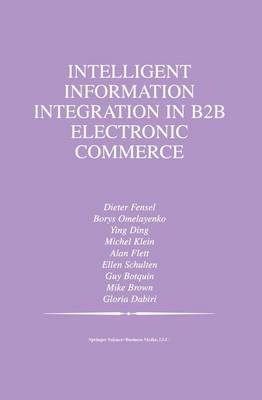The Springer International Series in Engineering and Computer Science
1 primary work
Book 710
Intelligent Information Integration in B2B Electronic Commerce
by Borys Omelayenko, Ying Ding, Michel Klein, Alan Flett, Ellen Schulten, Mike Brown, Guy Botquin, and Gloria Dabiri
Published 31 October 2002
Internet and web technology penetrates many aspects of our daily life. Its importance as a medium for business transactions will grow exponentially during the next few years. In terms of the involved market volume, the B2B area will hereby be the most interesting area. Also, it will be the place, where the new technology will lead to drastic changes in established customer relationships and business models. In an era where open and flexible electronic commerce provides new types of services to its users, simple 1-1 connections will be replaced by n-m relationships between customers and vendors.
This new flexibility in electronic trading will generate serious challenges. The main problem stems from the heterogeneity of information descriptions used by vendors and customers, creating problems in both manual trading and in direct 1-1 electronic trading. In the case of B2B market places, it becomes too serious to be neglected. Product descriptions, catalog formats and business documents are often unstructured and non-standardized. Intelligent solutions that mechanize the structuring, standardizing, aligning, and personalizing process are a key requisite for successfully overcoming the current bottlenecks of B2B electronic commerce while enabling its further growth. Intelligent Information Integration in B2B Electronic Commerce discusses the main problems of information integration in this area and sketches several technological solution paths.
Intelligent Information Integration in B2B Electronic Commerce is designed to meet the needs of a professional audience composed of researchers and practitioners in industry and graduate level students in Computer Science.
This new flexibility in electronic trading will generate serious challenges. The main problem stems from the heterogeneity of information descriptions used by vendors and customers, creating problems in both manual trading and in direct 1-1 electronic trading. In the case of B2B market places, it becomes too serious to be neglected. Product descriptions, catalog formats and business documents are often unstructured and non-standardized. Intelligent solutions that mechanize the structuring, standardizing, aligning, and personalizing process are a key requisite for successfully overcoming the current bottlenecks of B2B electronic commerce while enabling its further growth. Intelligent Information Integration in B2B Electronic Commerce discusses the main problems of information integration in this area and sketches several technological solution paths.
Intelligent Information Integration in B2B Electronic Commerce is designed to meet the needs of a professional audience composed of researchers and practitioners in industry and graduate level students in Computer Science.
